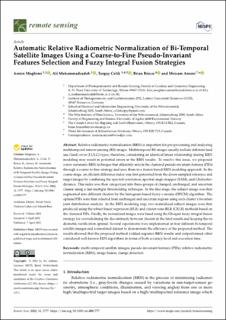Automatic Relative Radiometric Normalization of Bi-Temporal Satellite Images Using a Coarse-to-Fine Pseudo-Invariant Features Selection and Fuzzy Integral Fusion Strategies
Peer reviewed, Journal article
Published version
Permanent lenke
https://hdl.handle.net/11250/3013076Utgivelsesdato
2022Metadata
Vis full innførselSamlinger
Originalversjon
Moghimi, A., Mohammadzadeh, A., Celik, T., Brisco, B. & Amani, M. (2022). Automatic Relative Radiometric Normalization of Bi-Temporal Satellite Images Using a Coarse-to-Fine Pseudo-Invariant Features Selection and Fuzzy Integral Fusion Strategies. Remote Sensing, 14 (8), 27. https://doi.org/10.3390/rs14081777Sammendrag
Relative radiometric normalization (RRN) is important for pre-processing and analyzing multitemporal remote sensing (RS) images. Multitemporal RS images usually include different land use/land cover (LULC) types; therefore, considering an identical linear relationship during RRN modeling may result in potential errors in the RRN results. To resolve this issue, we proposed a new automatic RRN technique that efficiently selects the clustered pseudo-invariant features (PIFs) through a coarse-to-fine strategy and uses them in a fusion-based RRN modeling approach. In the coarse stage, an efficient difference index was first generated from the down-sampled reference and target images by combining the spectral correlation, spectral angle mapper (SAM), and Chebyshev distance. This index was then categorized into three groups of changed, unchanged, and uncertain classes using a fast multiple thresholding technique. In the fine stage, the subject image was first segmented into different clusters by the histogram-based fuzzy c-means (HFCM) algorithm. The optimal PIFs were then selected from unchanged and uncertain regions using each cluster’s bivariate joint distribution analysis. In the RRN modeling step, two normalized subject images were first produced using the robust linear regression (RLR) and cluster-wise-RLR (CRLR) methods based on the clustered PIFs. Finally, the normalized images were fused using the Choquet fuzzy integral fusion strategy for overwhelming the discontinuity between clusters in the final results and keeping the radiometric rectification optimal. Several experiments were implemented on four different bi-temporal satellite images and a simulated dataset to demonstrate the efficiency of the proposed method. The results showed that the proposed method yielded superior RRN results and outperformed other considered well-known RRN algorithms in terms of both accuracy level and execution time.

